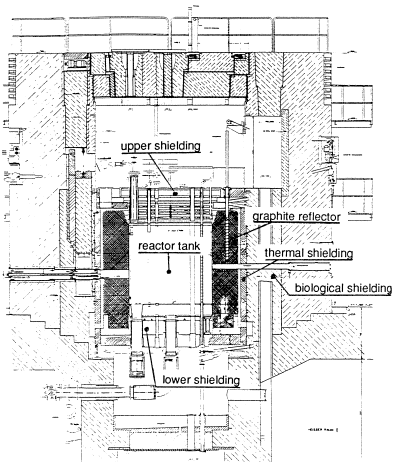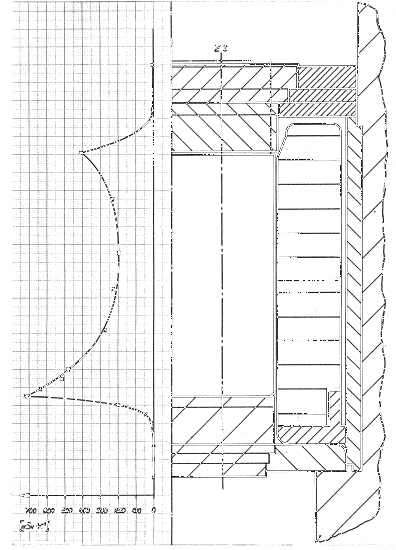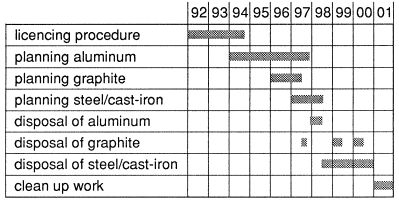
DECOMMISSIONING AND DISMANTLING OF THE
DIORIT RESEARCH REACTOR
Leibundgut F.
Paul Scherrer Institute,
CH-5232 Villigen, Switzerland
ABSTRACT
The DIORIT research reactor (30MW, natural uranium, D2O moderated), developed entirely by Swiss industry, was in operation from 1960 until 1977.
Its dismantling was planned in a two-year study between 1992 and 1994 and the necessary approvals obtained.
Four different material categories have to be considered in the case of DIORIT: aluminum, steel/cast-iron, graphite, and concrete. Each of these categories has particular characteristics which demand special treatment. Consequently it was necessary to develop and implement a disposal procedure, up to the final repository container stage for each of these categories.
Aluminum: Because of the production of H2 during solidification in concrete, it is necessary to minimize the surface area. When dismantling DIORIT, the aluminum removed was melted in an induction furnace and poured into a 4.5m3 concrete container to solidify. Cutting the metal and handling it was largely accomplished by remote control, using conventional technology.
Steel/Cast-iron: The storage containers to be filled determine the method used for reducing the size of these materials, and the technique used for handling them. The goal is to optimize the packing density to reduce repository costs. The favoured method of reducing the size of components is to cut them up using diamond-tipped tools, like saw blades.
Graphite: For graphite, compaction and burning are two options, and these are being discussed. Here, too, a cost/use analysis will determine the way to proceed.
Concrete: The disposal of this category of material is less of a problem. Mixing it as a filler material in containers with steel/cast-iron suggested itself, because of the storage volume saving which could be obtained.
The disposal of the aluminum is currently underway, and completion of the dismantling work is planned by the end of the year 2001.
INTRODUCTION
Stimulated by Prof. Paul Scherrer (Swiss Federal Institute of Technology, Zurich), the construction of a D2O-moderated, natural uranium research reactor (s. Fig. 1) was undertaken in Switzerland.
The long-term goal was to establish nuclear power as a new source of energy. The DIORIT research reactor with a thermal power of 20 MW was built between 1956 and 1960. During experiments supporting planning for the construction of an experimental power plant, occasional incidents occured. These caused cladding defects and contamination of the D2O-system with fission products. As a consequence of this, the reactor was rebuilt from 1970 to 1972 with an increase of thermal power. Thereafter, the reactor ran as DIORIT 2 until it was finally switched off on August 7, 1977.

Fig. 1. Vertical Section of the DIORIT II ResearchReactor
DECOMMISSIONING
The goal of the decommissioning of DIORIT in 1977 was to reach a safe condition for the public and environment, representing a minimal risk. In addition, the use of the area containing the reactor building for other purposes was intended. Supervising and preserving a safe condition was to be attained with a minimum of personnel. After taking the necessary technical and administrative steps, the facility was left for some years in this decommissioned condition.
A first concept for the complete dismantling of the research reactor was developed in 1980. At that time, the classification of the phases 0, 1A, 1B, 2A and 2B was effected (see below). Phases 0 and 1A had to be approved by the Swiss Federal Nuclear Safety Inspectorate (HSK). They started in 1982.
The permit to continue with phase 1B was given in 1983. It began that year, but because of financial bottle-necks, was interrupted in the same year.
Following a reorganisation of the institute in 1988, the complete dismantling of the DIORIT research reactor was decided. The phases planned in the original concept for dismantling were adapted and revised. They can be described as follows:
Phase 0 covers the dismantling of all inactive, non-contaminated, no-longer-required components. This phase was successfully completed in 1994. Incidentally, it showed that proceeding according to the original plan (serial realization of the phases 0, 1A and 1B) would not be optimal. Therefore, a pragmatic, step by step procedure, combining these three phases, was chosen and successfully realized.
A consequence of the phase 0 work was the disposal of a total of 141 metric tons of inactive waste.
Table I. Disposed Waste of DIORIT, Phases 0 B 2A
|
|
inactive |
active |
|
Phase 0 (1982; 1991 B 1994) |
141 000 kg |
B |
|
Phase 1A (1982; 1992 B 1993) |
82 300 kg |
16.5 m3 |
|
Phase 1B (1991 B 1994) |
230 750 kg |
69.9 m3 |
|
Phase 2A (1992) |
6 200 kg |
1.6 m3 |
|
Total: |
460 250 kg |
88 m3 |
Phase 1A covers the disposal of activated and/or contaminated reserve material. This phase also included disposal of parts of experimental equipment and components of other research laboratories of this institute. During this phase, more than 82 tons of inactive waste was disposed of and 16.5 m3 of low level waste was conditioned (s. Table I).
Phase 1B deals with the disposal of the contaminated components of the reactor. To allow reuse of the reactor building, the cooling loops, the ventilating system, and parts of the waste water system, together with the fuel element basin were rebuilt and/or decontaminated. This phase also included the clearing of a temporary storage area that contained components of DIORIT 1 (reactor tank, upper and lower shielding). Phase 1B, ran from 1991 until 1994, yielding more than 230 tons of inactive waste and 69 m3 of conditioned low level waste (s. Tab. 1).
Phase 2A covers the dismantling and disposal of all activated and contaminated components in the upper and the lower reactor chamber. Originally, in the course of this phase it was planned only to dismantle minor components in the reactor chambers. However, in order to get reliable radiation data for planning phase 2B, all installed components had to be removed from the reactor core. Therefore, by agreement with the Federal Nuclear Safety Inspectorate, all installations in the reactor tank, and all horizontal and vertical plugs were removed resulting in 6.2 tons of inactive waste and 1.6 m3 of low level waste in 1992 (s. Tab. 1).
Phase 2B refers to the final dismantling and disposal of the actual reactor block. In the original plan, this phase was not considered in detail. In 1992, however, the decision was made to dismantle the entire reactor block and to request cancelation of the permit to operate a nuclear facility.
PHASE 2B
In 1992, a technical report was submitted to the competent department, the Swiss Federal Department of Traffic and Power Industry, containing a detailed description of phase 2B.
In this report, the principle was established the reactor should be dismantled from the top-down and from the inside to the outside. In doing so, the surface of the reactor would remain closed as a rule, principally to maintain it always in a safe condition.
The procedure chosen was that the particular steps were written down in advance, but each step depended on experience from the previous steps. This way, one achieved the objective of first priority: to avoid the disturbance of other users of the building. Another objective is radiation protection. The goal is to realize phase 2B with less than 150 mSv of collective dose for all the staff involved in this work. With the given radiation conditions (s. Fig. 2), a careful optimization of every activity from the perspective of radiation protection is required.
Phase 2B proper was subdivided into 11 steps, beginning with the removal and disposal of the reactor tank and finishing with the dismantling of the inactive part of the biological shielding. This approach meant that the reactor could be brought into a safe condition for a long period (years) at any time, irrespective to the progress of work. Each step has to be approved and released by the authority.
From phase 2B, four categories of material result requiring different treatments. Fundamentally, all radioactive waste from DIORIT has to be conditioned and bound into a solid waste matrix, commonly with cement as the solidification material.
The reactor tanks of DIORIT 1 and DIORIT 2, a part of the upper shielding of DIORIT 1 and some small other components consist of aluminum (for example peraluman, an Al/Mg/Si alloy; or boral, Al with B4C). Because of the attributes of aluminum (production of H2 through corrosion in a basic environment), the surface of the waste must be minimized. This is achieved by melting in a crucible.

Fig. 2. Axial Dose Rate Distribution DIORIT II (1992)
The bulk of the radioactive waste is steel and cast-iron of the thermal shielding of the reactor. They are a problem not because of their chemical behavior, but because of their high radiation, up to 700 mSv/h, and because of their weights of up to 22 tons.
One part of the biological shielding, consisting of colemanit concrete, is also activated and has to be conditioned. However, this concrete presents no difficulty of any kind because it can be solidified together with steel and cast-iron in containers.
Finally, there are approximately 45 tons of chemically inert reactor graphite of the reflector. This material poses no significant problems with regard to the stored wigner energy and measures against its release. For the reactor graphite, all options are open, including burning as well as solidification.
ALUMINUM
The procedure for conditioning alloyed aluminum low level waste was chosen to meet the demands already mentioned. It can be described in six steps: preliminary treatment, dismantling, waste handling, melting, conditioning and interim/final storage.
The technique applied is essentially a conventional, well-tested one. It represents a novel solution at best as a complex combination of conventional procedures.
Because of the relative high g -dose rate up to 50 mSv/h, remote controlled dismantling and reduction to small pieces is imperative. Thus, transfers of material must take place remotely. The components to be dismantled have first to be transferred into the rooms assigned for cutting. For this purpose, pneumatically operated, remote controlled slings are used.
The cutting is done by tools that are capable of completing all necessary tasks without any access of operating staff. This includes a device for cutting tubes with a milling tool, operated remotely. In addition, there is a tank cutting tool, consisting of a machine tool, equipped with a band saw blade. Figure 3 shows an overview of the devices to cut the aluminum-containing components.
An extremly flexible manipulator enables the individual handling of each of the cut pieces. With it, they are brought to a scale for weighing, before they are fed to the induction furnace by the charging system. In this furnace, equipped with clay graphite crucibles, so-called 'reguli' of 52 kg each are melted.
By this means, the surface area of the aluminum can be reduced by about a factor of 20. The removal of the crucible from the furnace is done automatically without manual intervention, supervised from a control station equipped with video and audio devices in a separate, shielded room.
The possibility of accidents, such as an aluminum dust explosion, required complete vacuuming of the swarf.
With the facility installed, all four main components B both reactor tanks, light water shielding and boral-shielding B can be dismantled without manual intervention. The planning of the detailed work anticipates a collective dose below 5mSv for all tasks connected with the disposal of these components, including conservative estimates for several intervention doses in case of accidents.

Fig. 3. Aluminum Cutting Facility
STEEL/CAST-IRON AND COLEMANITE CONCRETE
There are around 250 tons of material in this category. They are parts of the thermal shielding, and contain components with a weight up to 22 tons. The suitable method of conditioning is simpler than that for aluminum alloys because the melting and all associated tasks are not required.
The raw waste is dismantled either in a shielded location in the former reactor building or in their position as built. The size of the pieces to be handled is given by the dimensions of the waste packages, as was the case for the aluminum waste. As cutting tools, diamond-tipped saw blades and diamond wire are employed. Trials at a 1 to 1 scale showed these to be a very reliable and efficient way of cutting these components. The estimated costs of cutting lie between CHF 600 (saw blades) and CHF 4000 (diamond wire) per square meter cutting area.
The maximum operation range of the assigned tools lies between 60 cm (saw blades) and 1 m (diamond wire). The maximum cutting performance for both methods amounts about 0.12 m2 steel per hour. If the surface being sawed consists of a combination steel/concrete, the cutting performance increases considerably, depending on the material proportions. In this case, because of so-called self-sharpening, maintenance time is reduced, significantly improving the efficiency of the process.
The dismantling of the components, followed by the loading of the containers follows an optimized sequence, leading to a combined filling with steel/cast-iron and concrete. Thus, each waste package can be filled most efficiently, causing a significant lowering of the final storage costs.
DECONTAMINATION
In course of phases 1A, 1B and 2A during 1992 and 1993, in a pilot facility, a total amount of 52 tons of contaminated material from the DIORIT research reactor was decontaminated. A volume reduction of about 50% was achieved compared to normal disposal as low level waste. Because of the use of the process by the entire Paul Scherrer Institute, the pilot facility was replaced by a permanent unit for chemical decontamination including that of a -contaminated materials.
This facility is set up and will be in operation in the middle of 1998.
SCHEDULE
Fig. 4 shows an overview of the programme. Precise planning for dismantling the reactor block was started in 1992. As mentioned, approval for the complete dismantling of the DIORIT research reactor followed in the autumn of 1994.
Because of the short time relative to financial and personnel resources, several activities could not begin together.

Fig. 4. Schedule for Dismantling DIORIT
Thus, disposal of aluminum was scheduled first. This work has begun and two of the three aluminum components, including 1600 kg of aluminum alloy are now dismantled. The goal is to dispose of all Pu- contaminated components in the first half of this year.
To support the next phase, planning of the equipment for dismantling the steel/cast-iron and concrete components is currently underway.
The start-up of this facility is planned for October of this year. As usual, the planning stage is effected through the Paul Scherrer Institute itself, in collaboration with small, flexible domestic companies.
Furthermore, fixed deadlines are not yet defined, due to their dependence on the financial situation of the Institute in the next years.
The aim of the Paul Scherrer Institute, to dismantle the reactor before 2001, remains unchanged, and should be achievable if no unforeseen troubles occur.
COSTS
The total costs estimated for the dismantling of the DIORIT research reactor reach CHF 26 millions (s. Tab. 2). All costs are included in this amount, even the costs for the final storage of the waste packages and the wage costs including overhead. Investments in facilities to be used after dismantling the reactor, like the decontamination laboratory, are included.
Considering the specific costs of waste, an average of CHF 61 '000 per m3 is expected. These costs include the final storage costs (» 50%) as well as the costs of dismantling the reactor (» 50%).
Table 2: Costs of Dismantling DIORIT in 1000 CHF
|
|
Salaries |
Hardware |
Final storage |
Total |
|
Phase 0 |
367 |
0 |
0 |
367 |
|
Phase 1A |
339 |
96 |
494 |
929 |
|
Phase 1B |
774 |
201 |
2097 |
3072 |
|
Phase 2A |
83 |
42 |
459 |
584 |
|
Phase 2B |
6537 |
4940 |
10011 |
21488 |
|
Total |
8100 |
5279 |
13061 |
26440 |
CONCLUSIONS
For dismantling the DIORIT research reactor, the Paul Scherrer Institute decided to use internal know-how as much as possible. On one hand, the knowledge of elder staff, working for other projects today but experienced with the construction and alteration of DIORIT could be utilized directly. On the other hand, the knowledge gained through this dismantling remains in the institute, adding efficiency to other dismantling projects.